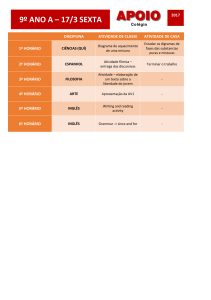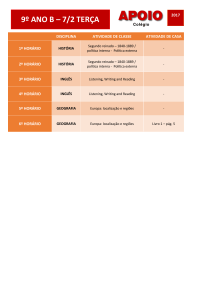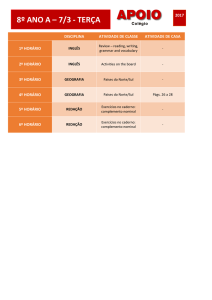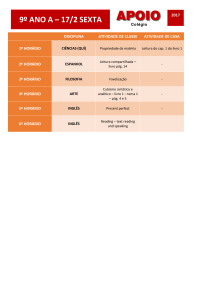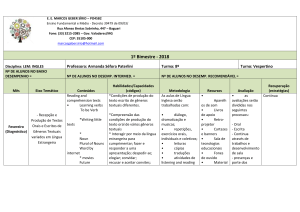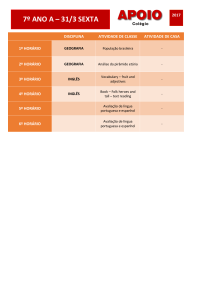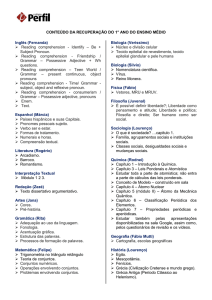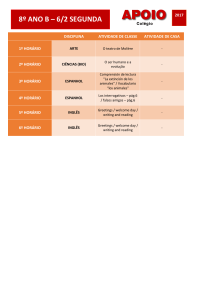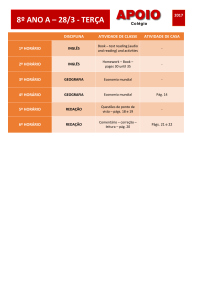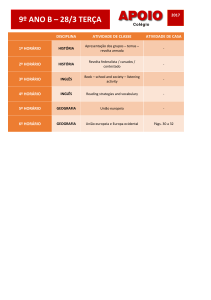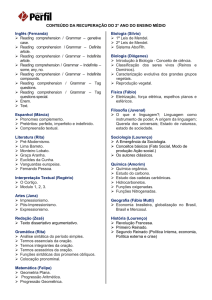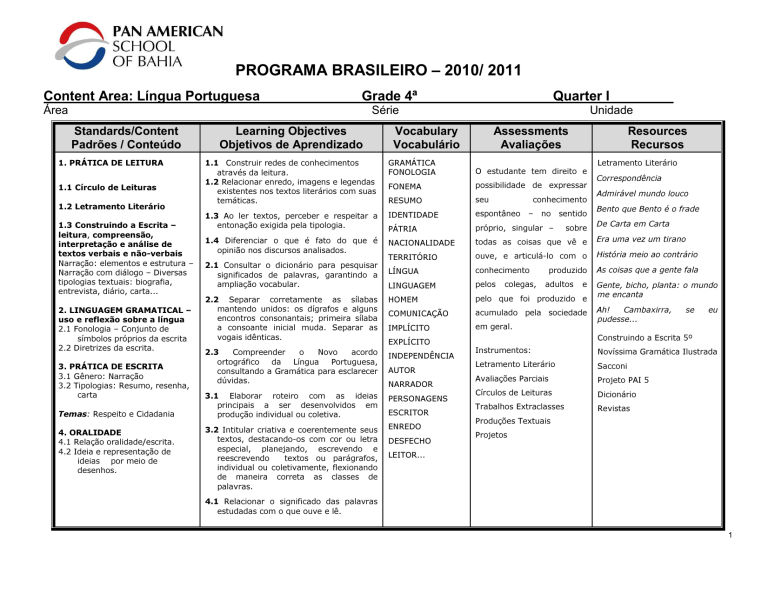
PROGRAMA BRASILEIRO – 2010/ 2011
Content Area: Língua Portuguesa
Grade 4ª
Área
Quarter I
Série
Standards/Content
Padrões / Conteúdo
1. PRÁTICA DE LEITURA
1.1 Círculo de Leituras
1.2 Letramento Literário
1.3 Construindo a Escrita –
leitura, compreensão,
interpretação e análise de
textos verbais e não-verbais
Narração: elementos e estrutura –
Narração com diálogo – Diversas
tipologias textuais: biografia,
entrevista, diário, carta...
2. LINGUAGEM GRAMATICAL –
uso e reflexão sobre a língua
2.1 Fonologia – Conjunto de
símbolos próprios da escrita
2.2 Diretrizes da escrita.
3. PRÁTICA DE ESCRITA
3.1 Gênero: Narração
3.2 Tipologias: Resumo, resenha,
carta
Temas: Respeito e Cidadania
4. ORALIDADE
4.1 Relação oralidade/escrita.
4.2 Ideia e representação de
ideias por meio de
desenhos.
Learning Objectives
Objetivos de Aprendizado
Unidade
Vocabulary
Vocabulário
Assessments
Avaliações
Resources
Recursos
Letramento Literário
1.1 Construir redes de conhecimentos
através da leitura.
1.2 Relacionar enredo, imagens e legendas
existentes nos textos literários com suas
temáticas.
GRAMÁTICA
FONOLOGIA
O estudante tem direito e
FONEMA
possibilidade de expressar
RESUMO
seu
1.3 Ao ler textos, perceber e respeitar a
entonação exigida pela tipologia.
IDENTIDADE
espontâneo
PÁTRIA
próprio, singular –
1.4 Diferenciar o que é fato do que é
opinião nos discursos analisados.
NACIONALIDADE
todas as coisas que vê e
Era uma vez um tirano
TERRITÓRIO
ouve, e articulá-lo com o
História meio ao contrário
2.1 Consultar o dicionário para pesquisar
significados de palavras, garantindo a
ampliação vocabular.
LÍNGUA
conhecimento
As coisas que a gente fala
LINGUAGEM
pelos
2.2 Separar corretamente as sílabas
mantendo unidos: os dígrafos e alguns
encontros consonantais; primeira sílaba
a consoante inicial muda. Separar as
vogais idênticas.
HOMEM
pelo que foi produzido e
COMUNICAÇÃO
acumulado pela sociedade
IMPLÍCITO
em geral.
2.3
Compreender
o
Novo
acordo
ortográfico
da
Língua
Portuguesa,
consultando a Gramática para esclarecer
dúvidas.
INDEPENDÊNCIA
3.1 Elaborar roteiro com as ideias
principais a ser desenvolvidos em
produção individual ou coletiva.
PERSONAGENS
3.2 Intitular criativa e coerentemente seus
textos, destacando-os com cor ou letra
especial, planejando, escrevendo e
reescrevendo
textos ou parágrafos,
individual ou coletivamente, flexionando
de maneira correta as classes de
palavras.
ENREDO
EXPLÍCITO
AUTOR
NARRADOR
ESCRITOR
DESFECHO
conhecimento
–
colegas,
no
sentido
sobre
produzido
adultos
e
Correspondência
Admirável mundo louco
Bento que Bento é o frade
De Carta em Carta
Gente, bicho, planta: o mundo
me encanta
Ah!
Cambaxirra,
pudesse...
se
eu
Construindo a Escrita 5º
Instrumentos:
Novíssima Gramática Ilustrada
Letramento Literário
Sacconi
Avaliações Parciais
Projeto PAI 5
Círculos de Leituras
Dicionário
Trabalhos Extraclasses
Revistas
Produções Textuais
Projetos
LEITOR...
4.1 Relacionar o significado das palavras
estudadas com o que ouve e lê.
1
BRAZILIAN PROGRAM – 2010/ 2011
Content Area: Língua Portuguesa
Área
Standards/Content
Padrões / Conteúdo
1. READING PRACTICE
1.1 Reading Circle
Reading Magazines
1.2 Literature Literacy
1.3 Building of the writing
number 5: Reading,
comprehension and
interpretation of verbal and
non-verbal Texts
Varied text typologies: biography,
interview, journal, letter...
2. TEXT’S GRAMMAR
LANGUAGE:
– use and reflection about the
language art
Grade 4ª
Série
Learning Objectives
Objetivos de Aprendizado
3. WRITTEN PRACTICE
3.1 Scheme, summary,
enumeration and testimony –
letter
3.2 Poem and prose/ Poetic
narrative and on prose.
Themes: Respect and Citizenship
4. ORATORY
4.1 Speak/writing relation. Idea of
representation and representation
of ideas through drawings and
designs.
Vocabulary
Vocabulário
Assessments
Avaliações
Resources
Recursos
GRAMMAR
The student has the chance
Literature Literacy
FONOLOGY
and right to express their
“Correspondência”
FONEMA
spontaneous knowledge – in
“Admirável mundo louco”
SUMMARY
their own sense, singular –
“Bento que Bento é o frade”
IDENTIFICATION,
over all that he or she sees
“De Carta em Carta”
PATRIARCH,
or hears. Articulate them
NATIONALITY,
“Era uma vez um tirano”
with
LANGUAGE,
“História meio ao contrário”
information
COMMUNIATION,
classmates, adults and by
IMPLICIT,
2.2 Separate correctly the syllables,
keeping
together
the
following:
digraphs, encounters consonant; the
initial consonant changes in the first
syllable. To separate identical vowels.
what was created and put
EXPLICIT
together
TERRITORY
general.
MAN KIND
Instruments:
3.1 Elaborate itinerary with the main ideas
to be developed in individual and
collective productions.
INDEPENDENCE
Literature Literacy
AUTHOR
Partial Assignments
NARRATOR
Reading Circle
CARACTERS
Homework
WRITER
Written Production
PLOT
Projects
1.1 Build up knowledge network through
reading.
1.2 Relate plot, images and captions
existing to their theme in literature
texts.
1.3 When reading texts, understand and
respect the pitch required by the
typology.
2.1 Consult the dictionary to research the
meaning of words, ascertaining to
amplify their vocabulary.
2.1 Set of writing’s symbols
2.2 Writing direction.
Quarter I
Unidade
3.2 Entitle creative and coherently its texts,
highlighting them with color or special
letter, planning, writing and rewriting
texts or paragraphs, individually or
collective, correctly using the
grammatical elements.
4.1 Relate the meaning of the studied
words with what they hear or read
outside of the classroom.
the
by
produced
by
society
LINGUAGE
CLOSING
READER...
their
in
“As coisas que a gente fala”
“Gente, bicho, planta: o mundo
me encanta”
“Ah!
Cambaxirra,
pudesse...”
se
eu
Literature’s books
Building of the writing number 5
Illustrated Grammar Dictionary
Brazilian magazines and
newspapers
Internet/ TV/ DVD/ CD
PROGRAMA BRASILEIRO – 2010/ 2011
Content Area: Língua Portuguesa
Área
Standards/Content
Padrões / Conteúdo
1. PRÁTICA DE LEITURA
1.1 Círculo de Leituras
1.2 Letramento Literário
1.3 Construindo a Escrita –
leitura, compreensão e
interpretação de textos
verbais e não-verbais:
Narração com descrição de
personagem – História em
Quadrinhos – Diversas tipologias
textuais: classificado, anúncio,
resenha... – Discursos: Direto e
Indireto.
2. LINGUAGEM GRAMATICAL –
uso e reflexão sobre a língua
2.1 SÍLABA – Tonicidade,
segmentação, número
2.2 PALAVRA – Encontros
Vocálicos e Consonantais –
Digrafos
2.3 Pontuação
2.4 Ortografia – Ampliação
vocabular (Prefixos e sufixos)
3. PRÁTICA DE ESCRITA
3.1 Gênero: Narração
3.2 Tipologias: Histórias em
Quadrinhos, Esquema
Temas: Real e Imaginário
4. ORALIDADE
4.1 Exposição oral de pontos de
vista Recontos, debates e
exposições.
4.2 Relação oralidade/escrita –
fato de opinião
Learning Objectives
Objetivos de Aprendizado
1.1 Construir redes de conhecimentos
através da leitura.
1.2 Ao ler textos literários, perceber e
respeitar a entonação das personagens,
relacionando os sentimentos
despertados por essas leituras.
1.3 Em textos lidos na própria fonte
(jornais, revistas, panfletos, cartazes...)
perceber a inexistência do espaço para
parágrafos, identificando suas ideias
básicas.
2.1 Usar o dicionário para consultar o
significado de palavras aplicadas,
ampliando o vocabulário.
2.2 Perceber o uso de letras maiúsculas na
grafia de períodos históricos, em nomes
de conceitos religiosos ou políticos:
Igreja, Estado, Nação...
2.3 Perceber a intenção do autor quando
da utilização de pontuação convencional
e diferenciada.
2.4 Compreender as funções de prefixos e
sufixos na formação e significado das
palavras.
3.1 Perceber a importância da legibilidade
da escrita para que as ideias sejam
realmente veiculadas.
3.2 Transcrever Discursos Diretos para
Indiretos e vice-versa.
4.1 Nas produções textuais, deixar clara
sua posição, seu ponto de vista,
utilizando argumentos procedentes para
sustentar as afirmações colocadas.
4.2 Diferenciar o que é fato do que é
opinião nos discursos analisados.
Grade 4ª
Série
Quarter II
Unidade
Vocabulary
Vocabulário
INTERTEXTUALIDADE
COERÊNCIA
INCOERÊNCIA
IDENTIDADE
LEITOR
ESTILOS
AFRICANIDADE
CONSCIÊNCIA
PRODUÇÃO
TEXTUAL
INDIVIDUAL
COLETIVO
GRAMÁTICA
VOCÁLICO
CONSONANTAL
TONICIDADE
Assessments
Avaliações
Resources
Recursos
O trabalho pedagógico é
Letramento Literário
avaliado
O Gato que falava Siamês
a
partir
da
produção do conhecimento
A Fada Enfadada
em um contexto/ambiente
A Bolsa Amarela
em
Os Colegas
que
o
diálogo,
a
confrontação de pontos de
História meio ao contrário
vista
Quando os Vilões se Encontram
e
de
ideias
estão
sempre presentes.
As coisas que a gente fala
Instrumentos:
Mano descobre a Paz
Letramento Literário
Mano descobre a Ecologia
Avaliações Parciais
Mano descobre a @mor
Círculos de Leituras
Mano descobre a Solidariedade
Trabalhos Extraclasses
Mano descobre a Liberdade
Produções Textuais
Mano descobre a Diferença
Projetos
Construindo a Escrita 5º
Novíssima Gramática Ilustrada
Sacconi
Projeto PAI 5
Dicionário
Revistas
3
BRAZILIAN PROGRAM – 2010/ 2010
Content Area: Língua Portuguesa
Área
Standards/Content
Padrões / Conteúdo
1. READING PRACTICE
1.1 Reading Circle
Reading Magazines
1.2 Literature Literacy
Sensible and attentive reading of
literary texts.
1.3 Building of the writing
number 5: Reading,
comprehension and
interpretation of verbal and
non-verbal
2. TEXT’S GRAMMAR
LANGUAGE:
– use and reflection about the
language art
2.1 Unity and paragraphs –
Cohesive elements – Word
and ideas articulation in the
text.
3. WRITTEN PRODUCTION
3.1 Gênero: Narração
3.2 Tipologias – HQ and squems
Themes: Real and imaginary
4. ORATORY
4.1 Oral exposure of different
perspectives
4.2 Re-telling tails, debates and
oral expositions – fact and
opinion
Grade 4ª
Série
Learning Objectives
Objetivos de Aprendizado
1.1 Build up knowledge network through
reading,
creating
knowledge
connections through the practice of
reading.
1.2 Through the reading of texts, notice
and respect character’s tones,
connecting the feelings awakened by
some texts with others.
1.3 In texts taken from the original source
(newspapers, magazines, pamphlets,
posters...), notice the lack of space for
paragraphs, and identify the basic ideas
in the texts that do not present
conventional spaces for paragraphs.
4.1 In textual productions, make clear your
position and perspective, using
precedent arguments that back up the
exposed affirmations.
2.1 Use the dictionary to consult the
meaning of applied words, expanding
your vocabulary.
2.2 Notice the use of caps-lock letters in
the writing of historic periods, in
religious or political concepts: Church,
State and Nation.
2.3 Notice the author’s intention when
using conventional and different
punctuation.
2.4 Understand the function of prefix and
suffix in the words’ form and
signification.
3.1 Notice the importance of legibility in
writing, so that ideas are truly
interconnected.
3.2 Rewrite direct speeches into indirect
and vice-versa.
4.2 Differentiate fact and opinion in
analyzed speeches.
Quarter II
Unidade
Vocabulary
Vocabulário
INTERTEXTUALITY
COHERENCE
INCOHERENCE
IDENTITY
READER
STYLES
AFRICANIDADE
CONSCIENCE
PRODUCTION
TEXTUAL
INDIVIDUAL
COLECTIVE
GRAMMAR
VOCÁLIQUE
CONSONANTAL
TONICITY
Assessments
Avaliações
The
academic
analyzed
work
through
Resources
Recursos
is
the
acquiring of knowledge from
a context/ environment in
which the dialogue, and the
crashing
of
different
perspectives and ideas are
always present.
Literature Literacy
O Gato que falava Siamês
A Fada Enfadada
A Bolsa Amarela
Os Colegas
História meio ao contrário
Quando os Vilões se Encontram
As coisas que a gente fala
Mano descobre a Paz
Instruments:
Mano descobre a Ecologia
Literature Literacy
Mano descobre a @mor
Partial Assignments
Mano descobre a Solidariedade
Reading Circle
Mano descobre a Liberdade
Homeworks
Mano descobre a Diferença
Written Production
Literature’s books
Projects
Building of the writing number 5
Illustrated Grammar Dictionary
Brazilian magazines and
newspapers
Internet/ TV/ DVD/ CD
4
PROGRAMA BRASILEIRO – 2010/ 2010
Content Area: Língua Portuguesa
Área
Standards/Content
Padrões / Conteúdo
1. LEITURA
1.1 Círculo de Leituras
1.2 Letramento Literário
1.3 Construindo a Escrita –
leitura, compreensão e
interpretação de textos
verbais e não-verbais:
Narração com descrição de
espaço – Monólogo
• Diversas tipologias textuais:
panfleto, manifesto, gráfico,
mapa, legenda...
2. LINGUAGEM GRAMATICAL –
uso e reflexão sobre a língua
2.1 Expansão de palavras e ideias
no texto – Pontuação
2.2 Acentuação – Classes de
Palavras – Concordância –
Ortografia – Ampliação
vocabular.
3. ESCRITA
3.1 Poesia
Temas: Comunicação e
sentimento
4. ORALIDADE
4.1 Argumentação oral e escrita a
partir de releituras, discussões
e exposições orais.
Learning Objectives
Objetivos de Aprendizado
1.1 Construir redes de conhecimentos
através da leitura, sintetizando as ideias
centrais dos textos lidos e compreender a
função de manchetes e títulos de
matérias em jornais e revistas.
1.2 Relacionar temáticas de textos
refletidos com outros consagrados
popularmente: músicas, provérbios,
poemas, filmes, programas de TV.
1.3 Perceber a existência de argumentos
em textos lidos individual e
coletivamente, diferenciando as
características peculiares de um texto
(informativo, jornalístico, de entrevista) e
a sua ideia principal.
Grade 4ª
Série
Vocabulary
Vocabulário
AMOR
DESAMOR
ALEGRIA
TRISTEZA
SAUDADE
ENCANTAMENTO
MANIFESTAÇÃO
CULTURAL
CLASSES
GRAMATICAIS
2.1 Substituir palavras dos textos
estudados por outras cujo significado é
do senso comum.
SUBSTANTIVO
2.2 Utilizar o dicionário para escrever
adequadamente as palavras, e a
gramática para acentuá-las e
classificálas.
VERBO
3.1 Nas produções escritas, conseguir
elencar os argumentos utilizados em
textos refletidos, conforme sua sequência
no texto.
NUMERAL
3.2 Perceber que nenhum texto é neutro –
que traz, implícito ou explicitamente, a
visão de mundo do autor, sua opinião,
seu ponto de vista.
CONJUNÇÃO
4.1 Expor suas ideias, dando relevância à
criatividade e à crítica.
Quarter III
Unidade
ADJETIVO
ARTIGO
PRONOME
ADVÉRBIO
PPREPOSIÇÃO
Assessments
Avaliações
O
processo
de
Resources
Recursos
ensino
Letramento Literário
aprendizagem é avaliado a
Manual de Delicadeza
partir da
O Poeta Aprendiz
valorização dos
processos de conhecer – a
Varal de Poesias
si, ao outro e a sociedade,
A arca de Noé
promovendo a mudança de
Poesia das Crianças
perspectiva,
Meus primeiros versos
de
eixo
de
análise.
Poesia das Capitais
Trem de Alagoas
Instrumentos:
Letramento Literário
Avaliações Parciais
Círculos de Leituras
Trabalhos Extraclasses
Produções Textuais
Projetos
Dia Mundial da Água
– 22/3
Palavras de Encantamento
Palavra de poeta
Construindo a Escrita 5º
Novíssima Gramática Ilustrada
Sacconi
Projeto PAI 5
Dicionário
Revistas
Jornais
INTERJEIÇÃO
CONCORDÂNCIA
5
BRAZILIAN PROGRAM – 2010/ 2011
Content Area: Língua Portuguesa
Área
Standards/Content
Padrões / Conteúdo
1. READING PRACTICE
1.1 Reading Circle
Reading Magazines
1.2 Literature Literacy
1.3 Building of the writing
number 5: Reading,
comprehension and
interpretation of verbal and
non-verbal:
Reading and written production
based on a variety of
typographical texts
2. TEXT’S GRAMMAR
LANGUAGE: use and reflection
about the language art
2.1 Expansion of words and ideas
in texts – verbal and nominal
agreements
2.2 Orthography – vocabulary
enhancement
Grade 4ª
Série
Learning Objectives
Objetivos de Aprendizado
1.1 Build up knowledge network through
reading, summarizing the main ideas of
the texts read.
1.3 To understand the existence of
arguments in texts read collectively,
understanding the function of headlines
and titles of essays and articles in
newspapers and magazines.
MYTHS
GODS
BELIEFS
REALITY
Assessments
Avaliações
The
2.2 Use the dictionary to write appropriate
words and grammar book employ them
correctly.
Themes: solidariedade, love,
amizade, ecology
4.1 Expose your ideas, giving importance
to creativity and criticism.
Resources
Recursos
teaching-learning
process is evaluated based
on
the
value
of
the
processes to know – you,
Literature Literacy
Manual de Delicadeza
O Poeta Aprendiz
Varal de Poesias
A arca de Noé
each other and the society,
Poesia das Crianças
promoting
of
Meus primeiros versos
of
Poesia das Capitais
the
perspective,
change
point
analysis.
Trem de Alagoas
Palavras de Encantamento
Instruments:
Literature Literacy
2.1 Replace the words of the texts studied
by others whose meaning is agreement.
3.1 Popular poety composition
4. ORATORY
4.1 Oral and written
argumentations –
argumentative retellings,
debates and oral expressions.
LOVE
IMAGINARY
3.1 In written production, list the
arguments used in texts reflected
according to their sequence in the text.
3. WRITTEN PRODUCTION
Vocabulary
Vocabulário
MYTHOLOGY
1.2 Relate reflected texts themes with
other commonly recognized: songs,
proverbs, poems, films, TV shows.
Quarter III
Unidade
Partial Assignments
Reading Circle
Homework
Written Production
Projects
Dezenove poemas
desengonçados
Palavra de poeta
A Fada Enfadada
O gato que falava siamês.
Literature’s books
Building of the writing number 5
Illustrated Grammar Dictionary
Brazilian magazines and
newspapers
Internet/ TV/ DVD/ CD
Poems by Brazilian poets
Books – notebooks – agendas –
maps – “atlas” – dictionaries –
grammar – internet – magazines
– encyclopedias – commercials –
newspaper’s texts – brochures
6
PROGRAMA BRASILEIRO – 2010/ 2011
Content Area: Língua Portuguesa
Área
Standards/Content
Padrões / Conteúdo
1. PRÁTICA DE LEITURA
1.1 Círculo de Leituras
1.2 Letramento Literário
1.3 Construindo a Escrita –
leitura, compreensão e
interpretação de textos
verbais e não-verbais:
Narração com descrição de espaço
1.4 Diversas tipologias textuais:
panfleto, manifesto, gráfico,
mapa, legenda...
2. LINGUAGEM GRAMATICAL –
uso e reflexão sobre a língua
2.1 Correspondência –
Reportagem e Notícia –
Ortografia – Ampliação
vocabular
2.2 Concordância textual.
3. PRÁTICA DE ESCRITA
3.1 Gênero: Narração
3.2 Tipologias: artigo, quadro
comparativo, instrução,
resumo, resenha, esquema...
Temas: História da humanidade
4. ORALIDADE
4.1 Estudo e vivência de textos
verbais e não-verbais,
especialmente os textos
teatrais.
4.2 Recontos, debates e
exposições orais.
Grade 4ª
Série
Learning Objectives
Objetivos de Aprendizado
1.1 Construir redes
através da leitura.
de
conhecimentos
1.2 Transitar entre diferentes gêneros
textuais (poético, jornalístico, literário,
científico), já denotando preferência por
alguns.
1.3 Estabelecer relações entre diferentes
linguagens com a mesma temática:
fotografia,
filmes,
histórias
em
quadrinhos,
músicas,
pinturas,
esculturas.
1.4 Utilizar-se de argumentos lógicos para
sustentar suas teses.
2.1 Selecionar, no dicionário, o significado
que melhor se adapte ao contexto
escrito.
Quarter IV
Unidade
Vocabulary
Vocabulário
MUSEU
DIREITOS
DEVERES
IGUALDADE
DESIGUALDADE
INCLUSÃO
EXCLUSÃO
NAÇÃO
POLÍTICA
JUSTIÇA
Assessments
Avaliações
A
auto-avaliação
é
______
Resources
Recursos
parte
Letramento Literário
determinante do processo
Os Doze Trabalhos de Hércules
educativo,
Ilíada
quando
analisadas
são
as
potencialidades e limitações
de
um
ambiente
de
aprendizagem, enfocando o
desenvolvimento
da
interatividade, cooperação e
autonomia.
SOCIEDADE
Odisséia...
Alice no País das Maravilhas
Romeu e Julieta
O Conde de Monte Cristo
O Rei Arthur e os Cavaleiros
daTávola Redonda
O Príncipe e o Mendigo
CIDADANIA...
Instrumentos:
2.2
Perceber
a
necessidade
de
concordância nominal e verbal na língua
falada
e
escrita,
interferindo
nas
reestruturações e produções coletivas,
consultando a gramática para realizar
concordâncias complexas.
CLASSES
Letramento Literário
GRAMATICAIS
Avaliações Parciais
Novíssima Gramática Ilustrada
SUBSTANTIVO
Círculos de Leituras
Sacconi
ADJETIVO
Trabalhos Extraclasses
Dicionário
3.1 Manter unidade nos discursos utilizados
em suas produções textuais.
VERBO
Produções Textuais
Revistas
ARTIGO
Projetos
3.2 Transitar com segurança
entre
diferentes
temáticas
textuais,
diferenciando fato de opinião nos
discursos analisados.
PRONOME
4.1
Compreender
a
relação
de
interdependência entre a existência do
homem
e
a
função
social
da
comunicação.
PPREPOSIÇÃO
4.2 Identificar conceitos científicos e
citações colocadas nos textos refletidos
como recurso argumentativo.
CONCORDÂNCIA
Construindo a Escrita 5º
NUMERAL
ADVÉRBIO
CONJUNÇÃO
INTERJEIÇÃO
7
BRAZILIAN PROGRAM – 2010/ 2011
Content Area: Língua Portuguesa
Área
Standards/Content
Padrões / Conteúdo
1. READING PRACTICE
1.1 Reading Circle
Reading Magazines
1.2 Literature Literacy
1.3 Building of the writing
number 5: Reading,
comprehension and
interpretation of verbal and
non-verbal:
Narration and Description
2. TEXT’S GRAMMAR
LANGUAGE: use and reflection
about the language art
2.1 Letter – news – orthography
2.1 Textual Concordance
3. WRITTEN PRODUCTION
Narrative and description
Themes: Humanity’s History
4. ORATORY
Dramatic Texts
Grade 4ª
Série
Learning Objectives
Objetivos de Aprendizado
1.1 To build up knowledge webs through
reading.
Vocabulary
Vocabulário
MUSEUM
1.2 Work with several written texts (poetic,
journalistic,
literary,
scientific),
demonstrating their preferences for some
of them.
RIGHTS
1.3
Establish
relationships
between
different languages under the same
theme: photography, films, comics,
music, paintings, sculptures...
UNEQUALITY
1.4 Use logic arguments to support their
thesis.
DUTIES
EQUALITY
INCLUSION
EXCLUSION
NATION
POLITICS
2.1 Select, from a dictionary, the
appropriated meaning of a word in a text.
JUSTICE
2.2 Realize the need of nominal and verbal
agreements in the oral and written
languages; interfering in the restructure
and group productions, using a grammar
book to work on more complex nominal
agreements.
CITIZENSHIP
3.1 Keep the same kind of speech used in
their textual productions.
ADJECTIVE
3.2 Turn direct speech into indirect speech
and vice versa.
ARTICLE
4.1 Identify scientific concepts and citations
that appear on texts as argumentative
resources.
SOCIETY
GRAMMATICAL
CLASSES
NOUN
VERB
PRONOUN
NUMERAL
ADVERB
PPREPOSITION
CONJUNCTION
INTERJECTION
CONCORDANCE
Quarter IV
Unidade
Assessments
Avaliações
Resources
Recursos
Self-evaluation is a
Literature Literacy
determinant part of the
Os Doze Trabalhos de Hércules
educational process, when
Ilíada
the potentialities and
Odisséia...
limitations of a learning
Alice no País das Maravilhas
environment are analyzed,
Romeu e Julieta
focusing on interactivity,
O Conde de Monte Cristo
cooperation and autonomy
O Rei Arthur e os Cavaleiros da
developments.
Távola Redonda
Instruments:
O Príncipe e o Mendigo
Literature Literacy
Literature’s books
Partial Assignments
Building of the writing number 5
Reading Circle
Illustrated Grammar Dictionary
Homework
Brazilian magazines and
Written Production
newspapers
Projects
Internet/ TV/ DVD/ CD
8

